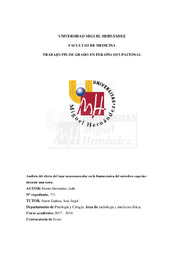Resumen :
El Ictus, es la enfermedad cerebrovascular más común. Es la primera causa de mortalidad en mujeres españolas y la segunda en varones. Además, es una de las principales causas de dependencia en el adulto. El vendaje neuromuscular, es una de las técnicas utilizadas para mejorar la calidad de vida de estas personar porque provoca efectos positivos en los sistemas analgésicos, el tono muscular, la postura, la propiocepción y la circulación.
Con este estudio, se pretende analizar si el uso del vendaje neuromuscular ayuda en la actividad de servirse y beber un vaso de agua. Para ello, se realizó un estudio de casos y control, con una muestra de 20 personas, dividida en dos grupos homogéneos. Para recoger la información, los participantes fueron grabados mientras realizaban tres veces esta actividad, seguidamente, se utilizaron tres técnicas diferentes de vendaje neuromuscular y se grabó de nuevo la actividad.
Los resultados mostraron diferencias significativas en el rango articular del hombro, al coger el vaso y beber, entre el grupo control y el grupo experimental sin vendaje (55,37±6,10 vs. 58,77±56,58 p-valor 0,016; 49,10±6,56 vs. 38,90±14,68 p-valor 0,045), sin embargo, al colocar el vendaje no existen diferencias significativas (55,37±6,10 vs. 48,07±10,22 p-valor 0.096; 49,10±6,56 vs. 44,17±15,58 p-valor 0.473). Lo mismo que ocurre con el desplazamiento del hombro con el vendaje.
En conclusión, podemos afirmar que el vendaje neuromuscular usado para la estabilidad de hombro, reduce las compensaciones. Por ello, sería interesante realizar más investigaciones que complemente el estudio y denuesten la eficacia de esta técnica
The stroke is the one of the most common cerebrovascular disorders. It represents the largest single cause of morbidity to Spanish women and the second to men. In addition, it is the largest single cause of dependence to adults. The neuromuscular bandage is one of the techniques used to improve the quality of life of these people because it shows positive effects on analgesic systems, muscular tone, posture, proprioception and circulation. This study goes through the analysis of the use of the bandages as a way of improving the activities of the patients while they are drinking a grass of water. For that purpose, we have studied the cases and the control of a sample of 20 people. These subjects were divided into two homogeneous groups. We record this people while they were performing the activity three times, in order to collect the information. Next, we use three different techniques of the bandages and we record the activity again. The results showed meaningful differences between the control group and experimental group in the shoulder articulation when they take the glass and drink water(55,37±6,10 vs. 58,77±56,58 p= 0,016; 49,10±6,56 vs. 38,90±14,68 p= 0,045), however, while the bandage is made, we cannot appreciate meaningful differences (55,37±6,10 vs. 48,07±10,22 p= 0.096; 49,10±6,56 vs. 44,17±15,58 p= 0.473). The same happens with the shoulder displacement when patients use the bandage. In conclusion, we can say that the neuromuscular bandage used for shoulder stability reduced compensations. Therefore, it would be interesting to conduct more research that complements the study and denudes the effectiveness of this technique
|
 La licencia se describe como: Atribución-NonComercial-NoDerivada 4.0 Internacional.
La licencia se describe como: Atribución-NonComercial-NoDerivada 4.0 Internacional.
.png)
